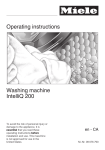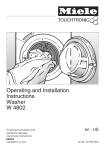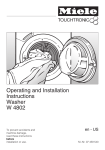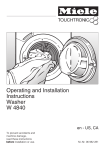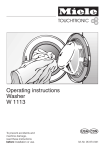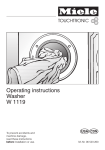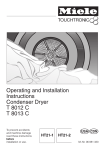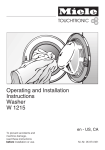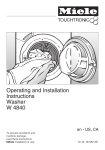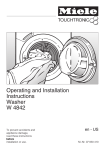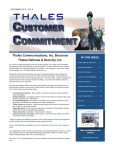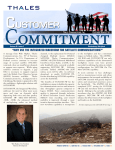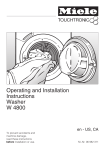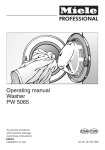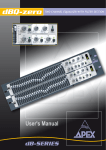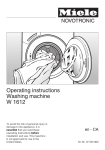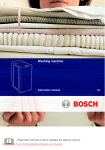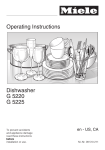Download Operating instructions Washing machine IntelliQ 100
Transcript
Operating instructions Washing machine IntelliQ 100 To avoid the risk of personal injury or damage to the appliance, it is essential that you read these operating instructions before installation and use. This maschine is not approved for use in the United States. en - CA M.-Nr. 09 076 870 Contents IMPORTANT SAFETY INSTRUCTIONS. . . . . . . . . . . . . . . . . . . . . . . . . . . . . . . . . 4 Guide to the washer. . . . . . . . . . . . . . . . . . . . . . . . . . . . . . . . . . . . . . . . . . . . . . . . 7 Control panel . . . . . . . . . . . . . . . . . . . . . . . . . . . . . . . . . . . . . . . . . . . . . . . . . . . . . . 7 Before using for the first time. . . . . . . . . . . . . . . . . . . . . . . . . . . . . . . . . . . . . . . . 8 Washing tips: . . . . . . . . . . . . . . . . . . . . . . . . . . . . . . . . . . . . . . . . . . . . . . . . . . . . . . 9 Using the washer . . . . . . . . . . . . . . . . . . . . . . . . . . . . . . . . . . . . . . . . . . . . . . . . . 10 1. Prepare and sort the laundry . . . . . . . . . . . . . . . . . . . . . . . . . . . . . . . . . . . . . . . 10 2. Load the laundry . . . . . . . . . . . . . . . . . . . . . . . . . . . . . . . . . . . . . . . . . . . . . . . . 11 3. Select a program . . . . . . . . . . . . . . . . . . . . . . . . . . . . . . . . . . . . . . . . . . . . . . . . 12 4. Select a temperature and final spin speed . . . . . . . . . . . . . . . . . . . . . . . . . . . . 12 Program guide . . . . . . . . . . . . . . . . . . . . . . . . . . . . . . . . . . . . . . . . . . . . . . . . . . . . 13 Final spin speed . . . . . . . . . . . . . . . . . . . . . . . . . . . . . . . . . . . . . . . . . . . . . . . . . . 15 5. Select an option . . . . . . . . . . . . . . . . . . . . . . . . . . . . . . . . . . . . . . . . . . . . . . . . . 16 6. Add detergent . . . . . . . . . . . . . . . . . . . . . . . . . . . . . . . . . . . . . . . . . . . . . . . . . . 17 Detergents . . . . . . . . . . . . . . . . . . . . . . . . . . . . . . . . . . . . . . . . . . . . . . . . . . . . . . . 19 Fabric after care . . . . . . . . . . . . . . . . . . . . . . . . . . . . . . . . . . . . . . . . . . . . . . . . . . 20 7. Start the program . . . . . . . . . . . . . . . . . . . . . . . . . . . . . . . . . . . . . . . . . . . . . . . . 21 8. Activate the Child Lock . . . . . . . . . . . . . . . . . . . . . . . . . . . . . . . . . . . . . . . . . . . 21 9. Program end . . . . . . . . . . . . . . . . . . . . . . . . . . . . . . . . . . . . . . . . . . . . . . . . . . . 22 Canceling a program . . . . . . . . . . . . . . . . . . . . . . . . . . . . . . . . . . . . . . . . . . . . . . . 23 Interrupting a program. . . . . . . . . . . . . . . . . . . . . . . . . . . . . . . . . . . . . . . . . . . . . . 23 Changing a program . . . . . . . . . . . . . . . . . . . . . . . . . . . . . . . . . . . . . . . . . . . . . . . 23 Adjusting the temperature . . . . . . . . . . . . . . . . . . . . . . . . . . . . . . . . . . . . . . . . . . . 23 Adjusting the spin speed . . . . . . . . . . . . . . . . . . . . . . . . . . . . . . . . . . . . . . . . . . . . 23 Changing an option . . . . . . . . . . . . . . . . . . . . . . . . . . . . . . . . . . . . . . . . . . . . . . . . 23 Adding/removing laundry during a wash program . . . . . . . . . . . . . . . . . . . . . . . . 24 Cleaning and care . . . . . . . . . . . . . . . . . . . . . . . . . . . . . . . . . . . . . . . . . . . . . . . . 25 Cleaning the exterior and control panel . . . . . . . . . . . . . . . . . . . . . . . . . . . . . . . . 25 Cleaning the drum . . . . . . . . . . . . . . . . . . . . . . . . . . . . . . . . . . . . . . . . . . . . . . . . . 25 Cleaning the dispenser drawer . . . . . . . . . . . . . . . . . . . . . . . . . . . . . . . . . . . . . . . 26 Quick guide . . . . . . . . . . . . . . . . . . . . . . . . . . . . . . . . . . . . . . . . . . . . . . . . . . . . . 27 2 Contents Cleaning and Care . . . . . . . . . . . . . . . . . . . . . . . . . . . . . . . . . . . . . . . . . . . . . . . . 27 Cleaning the water inlet filters . . . . . . . . . . . . . . . . . . . . . . . . . . . . . . . . . . . . . . . . 28 Frequently asked questions . . . . . . . . . . . . . . . . . . . . . . . . . . . . . . . . . . . . . . . . 29 A wash program cannot be started . . . . . . . . . . . . . . . . . . . . . . . . . . . . . . . . . . . . 29 The program was canceled, the buzzer sounds and the "Start" button flashes. . . 30 An error message is displayed at the end of a program. . . . . . . . . . . . . . . . . . . . 31 General problems with the washer . . . . . . . . . . . . . . . . . . . . . . . . . . . . . . . . . . . . 32 Unsatisfactory wash results . . . . . . . . . . . . . . . . . . . . . . . . . . . . . . . . . . . . . . . . . . 33 The drum door cannot be opened. . . . . . . . . . . . . . . . . . . . . . . . . . . . . . . . . . . . . 34 After sales service . . . . . . . . . . . . . . . . . . . . . . . . . . . . . . . . . . . . . . . . . . . . . . . . 37 Installation instructions . . . . . . . . . . . . . . . . . . . . . . . . . . . . . . . . . . . . . . . . . . . 39 Installation . . . . . . . . . . . . . . . . . . . . . . . . . . . . . . . . . . . . . . . . . . . . . . . . . . . . . . 40 Installation site . . . . . . . . . . . . . . . . . . . . . . . . . . . . . . . . . . . . . . . . . . . . . . . . . . . . 42 Removing the shipping struts . . . . . . . . . . . . . . . . . . . . . . . . . . . . . . . . . . . . . . . . 43 Leveling the washer . . . . . . . . . . . . . . . . . . . . . . . . . . . . . . . . . . . . . . . . . . . . . . . . 44 The Miele water protection system . . . . . . . . . . . . . . . . . . . . . . . . . . . . . . . . . . . . 45 Connecting to the water supply . . . . . . . . . . . . . . . . . . . . . . . . . . . . . . . . . . . . . . . 45 Drainage system . . . . . . . . . . . . . . . . . . . . . . . . . . . . . . . . . . . . . . . . . . . . . . . . . . 46 Electrical connection . . . . . . . . . . . . . . . . . . . . . . . . . . . . . . . . . . . . . . . . . . . . . . . 47 ELECTRICAL INSTRUCTIONS. . . . . . . . . . . . . . . . . . . . . . . . . . . . . . . . . . . . . . . . 47 Electrical connection . . . . . . . . . . . . . . . . . . . . . . . . . . . . . . . . . . . . . . . . . . . . . . . 47 Caring for the environment . . . . . . . . . . . . . . . . . . . . . . . . . . . . . . . . . . . . . . . . . 48 3 IMPORTANT SAFETY INSTRUCTIONS ,WARNING - To reduce the risk of fire, electric shock or injury to persons while using your appliance follow basic safety precautions, including the following: Read all instructions before installation or use to prevent injury and appliance damage. This appliance conforms to all uniform safety codes and regulations. Keep these operating instructions in a safe place and pass them on to any future user. SAVE THESE INSTRUCTIONS Correct usage ~ Only use the washing machine to wash items which are specified by the manufacturer to be machine washable on the fabric care label. Any other applications may be dangerous. ~ Persons who lack physical, sensory or mental abilities, or experience with the appliance should not use it without supervision or instruction by a responsible person. Children ~ Do not allow children to play on or in the appliance. Close supervision is necessary when the appliance is used near children. ~ The drum door glass will be hot when washing at very high temperatures. Do not touch the glass. Danger of burns! Keep children away from the washer when in use. 4 IMPORTANT SAFETY INSTRUCTIONS Technical safety ~ Do not install or use a washer with visible damage. ~ Before connecting the machine, ensure that the connection data on the data plate (fusing, voltage and frequency) match the mains electrical supply. If in doubt contact an electrician. ~ GROUNDING INSTRUCTIONS This appliance must be grounded. In the event of malfunction or breakdown, grounding will reduce the risk of electric shock by providing a path of least resistance for electric current. This appliance is equipped with a cord having an equipment- grounding conductor and a grounding plug. The plug must be plugged into an appropriate outlet that is properly installed and grounded in accordance with all local codes and ordinances. ~ WARNING - Improper connection of the equipment-grounding conductor may result in a risk of electric shock. Check with a qualified electrician if you are in doubt as to whether the appliance is properly grounded. ~ Do not modify the plug provided with the appliance - if it will not fit the outlet, have a proper outlet installed by a qualified electrician. ~ Do not use an extension cord to connect this appliance to the power supply. Extension cords do not guarantee the required safety of the appliance (e.g. danger of overheating). ~ Faulty components must only be replaced with genuine Miele spare parts. ~ Installation, repair and maintenance work should be performed by a Miele authorized service technician. Work by unqualified persons could be dangerous and may void the warranty. ~ Do not repair or replace any part of the appliance or attempt any servicing unless specifically recommended in these operating instructions. ~ If the power cord is damaged it must only be replaced by a Miele Service technician with a genuine Miele power cord. ~ Before servicing, cleaning or in the event of a fault, disconnect the appliance from the main power supply. ~ Only use a new hose kit to connect the washer to the water supply. Old hosing should not be re-used. ~ Under certain conditions, hydrogen gas may be produced in a hot water system that has not been used for 2 weeks or more. HYDROGEN GAS IS EXPLOSIVE. If the hot water system has not been used for such a period, turn on all hot water faucets and let the water flow from each for several minutes before using the washing machine. This will release any built-up hydrogen gas. Do not smoke or use an open flame during this time, the gas is flammable. ~ Before the appliance is removed for service or discarded, remove the door. 5 IMPORTANT SAFETY INSTRUCTIONS Safety ~ Do not install or store this appliance where it will be exposed to the weather. ~ Do not install the washing machine in rooms where temperatures below freezing may occur. ~ Before using the washer for the first time, remove the shipping struts at the back of the appliance (see "Installation - Removing the shipping struts"). Failure to remove the shipping struts can damage the washer and surroundings during spinning. ~ During extended absences (e.g., vacation), close the water supply. ~ Do not wash articles that have been previously cleaned, washed, soaked or spotted with gasoline, dry-cleaning solvents or other flammable substances. These articles give off vapors that could ignite or explode. Do not add these items to the wash load. ~ Do not add gasoline, dry-cleaning solvents, or other flammable or explosive substances to the wash water. These substances give off vapors which could ignite or explode. ~ Do not use cleaning solvents on or near the machine or the controls. Contact with cleaning solvents will damage the surface. ~ Danger of flooding! Before hanging the drain hose in the sink, make sure the water will drain away quickly enough. Secure the hose. The force of the water exiting the hose can cause an unsecured hose to pop out of the sink. ~ Do not reach into the appliance if ~ Ensure that no foreign objects are left in pockets (e.g. nails, coins, paper clips, etc.) this can cause damage to clothes and the machine. ~ Only use genuine Miele ~ Proper dosing of the detergent will eliminate the need to remove lime deposits. However, if heavy limescale does form on the washer, select a descaling agent with corrosion protection. Closely follow the instructions on the product package. 6 the drum is moving. ~ Do not tamper with the controls. Accessories accessories. If unapproved parts are used, guarantee, performance and product liability claims may become void. SAVE THESE INSTRUCTIONS AND REVIEW THEM PERIODICALLY Guide to the washer Control panel a PROGRAMS buttons eto select a wash program. b OPTIONS buttons Special features to enhance a wash program. c TEMP button to select the wash temperature. d SPIN speed button to select the spin speed. e PC Indicator allows a service technician to check and update the wash programs. f STATUS indicators shows the current cycle of the wash program. g Buzzer button turns the buzzer on and off. h FAULT indicators indicate errors and shows the activated Child Lock. i Start button starts the selected wash program. j Pause/Hold to cancel button pauses or cancels a program. 7 Before using for the first time The appliance must be correctly installed and connected before the first use. Please see the "Installation instructions." This washing machine has undergone thorough testing in the factory, there may be some residual water in the drum from this process. Running a spin cycle before the first use is not possible for safety reasons. To activate the spin cycle, a wash program must be run without laundry and without detergent. ^ Turn on the water supply. The washer is ready for the first use. The "Normal" program indicator lights. ^ Press the "Start" button. Once the program has finished the first use is complete. 8 Before using for the first time Washing tips: Detergent use Energy and water consumption – Use the recommended amount of detergent. – Do not overload the washer. The energy and water consumption will be most energy efficient. – Bear in mind the soiling degree of the laundry. – With smaller loads in the programs "Normal, Sanitize, Extra White and Custom" the washer automatically adjusts the water use to conserve water and energy. – If applicable use the program "Normal - Very Warm" instead of "Sanitize". It saves between 35% and 45% energy. For most soiling, this is sufficient. For stubborn soiling use the option "Pre-wash". – Use less detergent for small loads. Options selection (Extended, Pre-wash) Select for: – For light to normal soiled items without stains use a wash program without an option. – For normal to heavily soiled items with stains wash with the "Extended" option. – For heavily soiled items use a wash program with the "Pre-wash" option and "Extended". – Items with lager soiling, e.g. dust, sand, use a program with the option "Pre-wash". Tip: If you will be using a tumble dryer to dry the laundry – Select the highest spin speed suitable for the wash load to remove as much water as possible to save energy when tumble drying. 9 Using the washer 1. Prepare and sort the laundry Sort the laundry ^ Only wash items that are labeled machine washable by the manufacturer. Most garments have a fabric care label in the collar or side seam. ^ Sort the laundry by care label and color. General tips ^ Empty all pockets. ,Foreign objects left in pockets (e.g. nails, coins, paper clips, etc.) can cause damage to clothes and the machine. Pre-treat stains ^ Tough stains (blood, egg, coffee, tea, etc.) or badly soiled areas (collars and cuffs) should be pre-treated with a stain remover or a paste made from powder detergent and warm water. Dab stains with a damp light colored cloth. Do not rub! ,Do not use chemical solvents in the machine. 10 – Dark fabrics often bleed the first few times they are washed. They should be washed separately several times before being included in a mixed load. – Curtains: Remove any lead weights or strips before washing. – Loose bra underwires should be removed or sewn in place before washing. – Woolens, knitted garments, jeans, pants and sweat shirts should be turned inside out. – Close zippers, hooks and eyelets before washing. – Comforter covers and pillowcases should be fastened to prevent small items from rolling inside of them. – Do not wash items with the h symbol on the fabric care label. Using the washer 2. Load the laundry ^ Open the drum door. ^ Load the laundry loosely into the drum. For best results, wash mixed loads of small and large items. This will improve washing effectiveness and help distribute the load evenly. ^ Close the drum door. To prevent damage, make sure that there is no clothing caught between the drum door and the seal. ^ Close the drum door. 11 Using the washer 3. Select a program 4. Select a temperature and final spin speed The preselected temperature and/or spin speed can be adjusted if the program allows for it. See the "Program Guide". ^ Press the "PROGRAMS" button e or - until the desired program indicator lights. ^ Press the "TEMP" and "SPIN" button until the indicator of the desired setting lights. 12 Using the washer Program guide Temperature Final Spin Item / Tip Options: Extended, Pre-wash, Sensitive, Buzzer Normal Hot D Sanitize C Warm B Cold A Items made from cottons, linen or mixed fabrics. Max No Heat Important: Fill the drum only 3/4 of the way. Items need room to move otherwise they might get caught in the drum door seal. Options: Extended, Pre-wash, Sensitive, Buzzer Wrinkle-free Hot J Very warm I Max Warm H High Cold G Items made from synthetics, mixed fabrics or wrinkle free cottons. No Heat Options: Extended, Pre-wash, Sensitive, Buzzer Sanitize Sanitize E Max Hot D High Options: Extended, Pre-wash, Sensitive, Buzzer Extra White Hot D Max Very warm C High For white items without special hygienic requirements. Options: Extended, Buzzer Delicates Warm N Med Cold M Slow No Heat Items which have come in contact with the skin or have special hygienic requirements. For delicate items made from synthetics. Hold No spin The default settings are highlighted in bold. 13 Using the washer Temperature Final Spin Item / Tip Options: Sensitive, Buzzer Woolens Warm High Cold Med No Heat Slow Items made from washable wool and mixed woolens. Hold No Spin Options: Buzzer Express Warm B Max Cold A High No Heat Small loads of mixed items without a high degree of soiling. Med Slow Hold No Spin Options: Extended, Pre-wash, Sensitive, Buzzer Sturdy Warm High Cold Med No Heat Slow Options: Extended, Pre-wash, Sensitive, Buzzer Custom Sanitize E Max Hot D High Sanitize C Med Warm B Slow Cold A Hold No Heat Clean Machine Sanitize 14 All items made from denim Before washing denim items turn them inside out. All options freely selectable for Sanitize and Normal items No Spin Options: Buzzer Max To clean the drum and all waterways. Run program without laundry. Using the washer Final spin speed Hold Program Normal Max Wrinkle-free High Sanitize Max ^ Select "Hold". The laundry is not spun and remains soaking in water. This will prevent wrinkles if the laundry is not removed immediately at the end of the wash program. Extra White Max Delicates Med – Selecting / Starting the final spin Woolens High Express Max Sturdy High The washer is set by default to the maximum spin speed of the wash program. Custom Max Clean Machine – ^ You can select a lower spin speed. Press "Start" to start the final spin. The final spin speed can be reduced, if the program allows changes. The selection of a final spin speed higher than that shown above is not possible. – Finishing the program Rinse spin No spin (Deselect rinse spin and final spin) The laundry is spun after the main wash and between rinse cycles. Reducing the final spin speed will also reduce the rinse spin speeds. ^ Select "No Spin". The water is drained away after the last rinse. ^ Press the "Pause" button until the program ends. 15 Using the washer 5. Select an option Extended For laundry with normal to heavy soiling or stains. The main wash cycle time for the wash program will be extended. Pre-wash For heavily soiled laundry. For stubborn stains which are dried on. A pre-wash takes place and the wash time for the main wash is extended. ^ Select the desired Option with the respective button. Once an Option is selected the indicator lights. ^ See the Program Guide to find which Option is selectable for what program. If an Option cannot be selected, the wash program does not permit it. 16 Sensitive An additional final rinse that washes away detergent residue and scents. Buzzer A buzzer sounds the end of the wash program or after "Hold". The buzzer sounds until the washer is turned off. Using the washer 6. Add detergent Front loading washing machines require significantly less detergent than traditional top loaders. Closely follow the requirements of the detergent manufacturer. Use detergent according to the laundry soiling and water hardness. Light soiling No soiling or stains are visible. Normal soiling Some visible soiling or a few light stains. Heavy soiling Very visible soiling or stains. Use the "Pre-wash" function and add detergent in the Heavy soil compartment as described. Too little detergent may cause: – Ineffective cleaning of laundry; fabrics may become gray and stiff over time. – Grease stains on the laundry. – Hard water deposits on the heating element. Too much detergent may cause: – Over sudsing with minimal drum movement; poor wash, rinse and spin results. – Higher water consumption through an automatic, additional rinse cycle. – Higher environmental burden. 17 Using the washer ^ Add detergent to the desired compartments. – Main wash Detergent for the main wash – Heavy Soil Detergent for the pre-wash – Bleach Bleach used as described by the manufacturer; placed in the bleach compartment ^ Pull out the detergent dispenser drawer. – Softener Fabric softener or liquid starch ^ Add detergent to the Main Wash compartment at the beginning of each wash program. ^ Only add detergent (1/4 total recommended amount) to the "Heavy Soil" compartment, if the "Pre-wash" option was selected. ^ Close the detergent drawer. ^ If you do not use bleach, please remove the insert from the main wash compartment. 18 Using the washer Detergents You can use all high efficiency detergents which are formulated for household washing machines. Closely follow the requirements of the detergent manufacturer. Universal Color Delicate Special Bleach Fabric Softener Normal X X – – X X Wrinkle-free X X – – X X Sanitize X – – – X X Extra White X – – – X X Delicates – – X X X X Woolens – – – X – – Express1) X X – – – X 1) X X X X X X Custom X X – – X X Clean Machine – – – – X – Sturdy 1) only liquid detergent Miele offers a variety of specialized laundry detergents and fabric softeners, each uniquely designed to meet your individual laundry care needs. For more information visit the www.miele.ca web site or the Miele Boutique at http:// www.miele.ca/miele/canada/boutique.asp. 19 Using the washer Fabric after care Bleach Fabric softener Makes fabrics feel softer and reduces static cling in the dryer. Mild liquid starch A synthetic starch wash that gives fabrics some stiffness. Starch Gives the fabrics stiffness and volume. ^ Pour bleach into the bleach compartment. During the Main Wash the bleach will be automatically rinsed from the compartment and added to the cycle. Dyes / Dye removers ^ Add the fabric softener or mild liquid starch to the "Softener" compartment. Do not exceed the maximum fill level marked inside the compartment. The fabric softener / liquid starch will be dispensed during the final rinse. A small amount of water will remain in the compartment at the end of the program. If starching frequently, clean the dispenser compartment and especially the siphon tube. 20 The use of dyes in the washer is recommended only to a degree of usual household use. The salt used for dying may corrode the stainless steel with frequent use. ^ Use as directed by the manufacturer. ,Do not use dye removers in this washer! Using the washer 7. Start the program 8. Activate the Child Lock (if desired) The Child Lock prevents a program from being canceled. ^ Press the flashing "Start" button. When pressing the "Start" button, do not press and hold the button. Only a brief tap is necessary. The washer shows the current cycle of the wash program under "STATUS". The drum door will be locked when the program starts. The drum light turns off after the program starts. ,If a program was started without detergent, cancel the program first. Add detergent, then select and start a program again. ^ Press the "OPTIONS" button until the "FAULT" indicator "Child Lock" lights. Deactivate the Child Lock ^ Press the "OPTIONS" button until the "FAULT" indicator "Child Lock" goes out. Once the program has finished, the Child Lock must be deactivated. 21 Using the washer 9. Program end ^ Open the drum door. ^ Remove the laundry. Check the drum for any missed pieces of laundry. Items inadvertently left in the washer may be damaged (e.g. shrink or discolor) during the next wash cycle. ^ Check the folds of the door seal for any small articles which may have been trapped. ^ Close the drum door. ^ Activate the Child Lock for safety reasons. ,Children, animals or foreign objects may find their way into the drum. Danger of injury and damage to the machine! 22 Using the washer Canceling a program Interrupting a program A program can be canceled any time after a program start. ^ Press the "Pause" button briefly. ^ Press the "Pause" button until the "STATUS" indicator "Drain/Spin" indicator lights. The wash water will be drained away. To add or remove laundry ^ Open the drum door. To select another program ^ Select a new program with the e buttons. The washer interrupts the program and unlocks the door. Continue: ^ Tap the "Start" button. Changing a program A program change is not possible after a program has started. To change a program, the program must be canceled first. Adjusting the temperature The temperature can be changed up to 6 minutes after the program start. Adjusting the spin speed The spin speed can be adjusted anytime until the beginning of the final spin. Changing an option The options "Extended or Sensitive" can be selected up to 6 minutes after the program start. The "Buzzer" can be selected or deselected at any time. 23 Using the washer Adding/removing laundry during a wash program The drum door cannot be opened if: – the water temperature is greater than 130°F (55°C). – the water level is too high. – the program has reached the "Final Spin". ^ Press briefly the "Pause" button. ^ Open the drum door. ^ Add or remove the piece of laundry. ^ Close the drum door. ^ Press the "Start" button. The program will continue automatically. 24 – The Child Lock function is activated. Cleaning and care ,Before cleaning or maintenance, disconnect the power supply by unplugging the unit or manually "tripping" the circuit breaker. ,Do not hose the washer down. Cleaning the exterior and control panel Cleaning the drum To ensure that your machine remains clean and free of any soil build-up or odors, the washer comes equipped with a self-cleaning program for the drum and water lines. It is suggested to run this program approx. once a month. The program is completed without laundry in the drum. ^ Clean the exterior of the washer with a mild solution of non-abrasive detergent or soap and water, then wipe dry with a soft cloth. ^ Clean the drum with a stainless steel cleaner specially formulated for use on washing machines (available from Miele). ,Do not use chemical solvents, abrasive cleaners, glass or allpurpose cleaners! They will damage the surface. ^ Load approx. ½ cup of bleach into the Bleach compartment. Do not exceed the max. fill mark (small triangle on the sides). ^ Close the door. ^ Select the Clean Machine program. ^ Press the Start button. Once the program is finished: ^ Clean the dispenser drawer as described on the following pages. 25 Cleaning and care Cleaning the dispenser drawer Regularly remove any detergent residue. ^ Remove the lid from the bleach container and clean both parts thoroughly in warm water. ^ Re-attach the lid. ^ Pull the detergent drawer out until it stops, press down the release catch, and remove the drawer from the washer. ^ Remove the bleach compartment to clean it. 26 ^ Clean the "Heavy Soil" and "Main Wash" compartments with warm water. ^ Put the bleach container back in the "Main Wash" compartment. Quick guide Remove this guide for easy reference Please read all instructions, especially the "Important Safety Instructions", before using the washer. Quick guide 1. Sort the laundry 3. Select a program ^ Empty all pockets. ^ Select the desired program. ^ Sort the laundry by fabric and color. The indicator of the selected program lights. ^ Pre-treat stains. 2. Load the laundry 4. Select a temperature and spin speed The preselected temperature and/or spin speed can be adjusted if the program allows so. ^ Open the drum door and load the laundry. ^ Close the drum door. To prevent damage to the door seal and clothing, make sure no clothing is caught between the drum door and seal. ^ Press the "TEMP" and "SPIN" button until the indicator of the desired setting lights. Quick guide 5. Select an Option 7. Start a program ^ Tap the flashing "Start" button. 8. Activate the Child Lock ^ Select the desired "OPTIONS". Press the upper button until the indicator/s of the desired option light/s. 6. Add detergent ^ Press the "OPTIONS" button until the "FAULT" indicator "Child Lock" lights. ^ Deactivate the Child Lock after the program has finished. 9. Unload the laundry ^ Open the drum door. ^ Add detergent in the respective compartments. ^ Remove the laundry. Check the drum for any missed pieces of laundry. Items inadvertently left in the washer may be damaged (e.g. shrink or discolor) during the next wash cycle. Quick guide Program guide No in Sp ld Ho d gh x at He w Slo Me Hi Ma No ld Co Wa rm Wa ry Ve t Ho e iz nit Sa rm Normal Wrinkle-free Sanitize X X X X X X X X X X X Extra White X X X X X X X X X Woolens X X X Express X X X X X X X X X X Ex St Cu Delicates Sturdy Custom X Clean Machine X X X X X X X X X X X X X X X X X X X X X X X X X X X X X Options X e hin X X ac X X nM X X ea X Buzzer m Sensitive Cl X X dy X X s X X es ns X X sto ur pr s ole Wo X Pre-wash fre ite Wh ate lic De tra Ex ize le- al ink nit Sa Wr rm No Extended e The default settings are highlighted in bold. X X X X X X X X X X X X Cleaning and Care Siphon tube and channel Cleaning the detergent drawer niche 1. Remove the siphon tube from the "Softener" compartment and rinse under warm water. Also clean the pipe connected to the siphon tube. ^ Use a bottle brush to remove any detergent residue and lime deposits from the jets inside the detergent drawer. 2. Put the siphon tube back into place. ^ Slide the drawer back into place. ^ Clean the fabric softener channel with warm water and a brush. Clean the siphon tube and fabric softener channel more often if you frequently use liquid starch. Liquid starch tends to build up. 27 Cleaning and care Cleaning the water inlet filters The washer has two water inlet filters to protect each inlet valve. These filters should be checked and cleaned if necessary every 6 months. This may need to be done more frequently with some water supplies. ^ Remove the rubber seal, 1, from the connector. ^ Using needle nose pliers, grasp the ^ Turn off the water supply. ^ Unscrew the inlet hose from the valve by turning the connector counterclockwise using a wrench if necessary. plastic filter, 2, and pull it out of the hose connector. ^ Clean the filter under running water and carefully remove any large particles. ^ Replace the filter and seal then reconnect the hose. ^ Slowly turn on the valve and check for leaks. If water leaks, tighten the bolt. Both filters must be put back in place after cleaning. 28 Frequently asked questions ,Repairs to electrical appliances must only be carried out by a qualified and trained person in accordance with local and national safety regulations. Repairs and other work by unqualified persons could be dangerous. The following section will help you avoid placing a service call by identifying issues you may encounter while operating the machine: A wash program cannot be started Issue Possible cause A "PROGRAMS" The washer has no indicator does not light power. and the "Start" button does not flash. Immediately after the program start the washer cancels the program. The "child entrapment sensor" has reacted. Solution Check to determine if: – the washer is plugged in. – the circuit breaker has been tripped. ^ Open the drum door. ^ Check the drum for small children or animals. ^ Restart the program. 29 Frequently asked questions The program was canceled, the buzzer sounds and the "Start" button flashes. Issue Possible cause Solution – To turn off the fault message: Open the drum door or press and hold the "Pause/Hold to Cancel" button until the fault message goes out. The "FAULT" indicator – The drain is "Drain" lights. blocked. – The drain hose is too high. – Clean the drain filter and the drain pump. – The maximum drain pump height is 3 ft (1 m). The "FAULT" indicator The water intake is "Intake" lights. blocked. Possible fault: – Check if the water supply is open all the way. – the inlet hose is kinked. The "FAULT" indicators "Intake" and "Drain" light. The waterproof system has activated. There is a fault. The "STATUS" indicators "Pre-Wash" and "Main Wash" light. The buzzer sounds and the "Buzzer" indicator lights. 30 The door is not closed properly. Contact Technical Service. Start the program once more. If the fault message appears again call Technical Service. – Open the door and check for any obstructions. – Close the door. – Press "Pause/Hold to Cancel" for at least 5 seconds. – Press "Start". Frequently asked questions An error message is displayed at the end of a program. Issue Possible cause Solution – To turn off the fault message: Open the drum door or press and hold the "Pause/Hold to Cancel" button until the fault message goes out. The "FAULT" indicator The drain is blocked. Clean the drain filter and the "Drain" lights. drain pump. The "FAULT" indicator The water intake is "Intake" lights. blocked. Possible fault: Check if the water supply is open all the way. The "FAULT" indicator The machine has "Over sudsing" lights. over sudsed. Use less detergent in the next wash program, and follow the recommended amount on the detergent packaging. 31 Frequently asked questions General problems with the washer Problem Possible cause Remedy The washer shakes during spin cycles. The feet are not level and/or the nuts are not properly tightened. The pump is making unusual noises. This is not a fault. Lapping sounds at the beginning and end of the pump process are normal. Large residues of detergent remain in the dispenser drawer. The water pressure is too Clean the water inlet filter. low. Powdered detergents used along with water softeners tend to clump. Some fabric softener The siphon tube is clogged or not remains behind in the positioned correctly. compartment, or there is too much water in the compartment. There is a odor coming from the washer. 32 Level the machine see, "Installation - Leveling the Washer", and tighten the nuts. Clean the detergent compartment. In the future, first load the detergent into the compartment, followed by the water softener. Clean the siphon (see "Cleaning and care Cleaning the dispenser drawer"). Only low-temperature Run the Clean Machine programs have been run. program to clean the washer (see "Cleaning and care"). Frequently asked questions Unsatisfactory wash results Issue The laundry is not clean enough when using liquid detergent. Possible cause Solution Liquid detergents do not – Use powder detergents contain bleaching containing bleach. agents. Fruit, coffee and – Pre-treat stains tea stains may not be removed. Laundry has a gray – Not enough detergent – Add more detergent to sticky residue. was used to dissolve laundry with grease stains or use a liquid detergent. greasy deposits on heavily soiled laundry. – Run the "Sanitize" program without laundry using liquid – The laundry was soiled with grease, detergent to clean the e.g. oils, lotions, etc. washer before using it for laundry again. There is white detergent residue on dark laundry. The detergent has not completely dissolved because of hard water. These residues are difficult to remove. – After drying, remove white residues with a clothes brush. – In the future add a water softener to the detergent. 33 Frequently asked questions The drum door cannot be opened Possible cause Solution The door is locked during the wash cycles. Press the "Pause" button. The door lock opens. The Child Lock is activated. Deactivate the Child Lock as described in the chapter "Using the washer - Activate the Child Lock". Power failure Open the door as described on the following page. There is still water in the drum and the washer cannot drain the water. Clean the drain filter and drain pump. See "Cleaning and Care - Cleaning the drain pump and lint trap". As a safeguard against scalding, the drum door cannot be opened if the wash water temperature is over 130°F (55°C). 34 Frequently asked questions Opening the drum door during a power failure or when the drain is blocked ,Pull the plug from the electrical outlet before cleaning the washer! If the drain is clogged there will be water in the machine (max. 9.25 gal [35 l]). ,Make sure the machine is turned off and the drum has stopped turning. A moving drum is dangerous. ^ Place a container under the drain tube. ^ Open the detergent dispenser drawer and remove the tool. ^ Open the drain filter until water runs out, but do not take it out completely. ^ If the container becomes too full, interrupt the water flow by tightening the drain filter. ^ Discard the water and continue. ^ Open the lint trap door. 35 Frequently asked questions Once the flow of water stops: ,If the drain filter is not securely tightened water will leak out when the machine is used. Opening the drum door ,Make sure the machine is turned off and the drum has stopped turning. A moving drum is dangerous. ^ Pull out the detergent drawer. ^ Remove the drain filter. ^ Clean out any foreign objects or lint from the filter. ^ Insert a screw driver into the slot of the emergency opener and pull upwards. The door will now open. ^ Check that the drain pump impeller (in the back of the chamber) rotates freely by spinning it with your hand. ^ Return the drain filter and tighten it into place. 36 After sales service Repairs MieleCare In the event of a fault which you cannot fix yourself, please contact the service number on the back of this manual. (only USA) When contacting the Service Department, please quote the model and serial number of your appliance. This information can be found on the data plate located at the door hinge. PC Update The indicator marked PC allows a technician to make use of new technology. When, for example, new programs are developed or new fabrics are introduced, a service technician will be able to modify existing program cycles accordingly. Miele will provide information when such possibilities become available. MieleCare, our Extended Service Contract program; gives you the assurance of knowing that your appliance investment is covered by 5 years of worry free ownership. MieleCare is the only Extended Service Contract in the industry that guarantees repairs by a Miele Authorized Service Provider using genuine Miele parts. Only genuine Miele parts installed by factory trained professionals can guarantee the safety, reliability and longevity of your Miele appliance. Please note that unless expressly approved in writing by the Miele Service department, Extended Service Contracts offered by other providers for Miele products will not be recognized by Miele. Our goal is to prevent unauthorized (and untrained) service personnel from working on your Miele products, possibly doing further damage to them, you and/or your home. To learn more about MieleCare Extended Service Contracts, please contact your appliance dealer or visit us online at: http://miele.com/mielecare Optional accessories Optional accessories are available through your Miele dealer or Miele. 37 38 Installation Instructions To prevent accidents and appliance damage read these instructions before installation or use. 39 Installation Front view a High pressure intake hose, red mark for hot water b High pressure intake hose, blue mark for cold water c Power cord d - g Flexible drain hose with detachable swivel elbow (drain options shown) 40 h Control panel i Detergent dispenser drawer and door opener in case of power failure j Drum door k Access panel to lint trap and drain pump l Four height-adjustable feet Installation Rear view a Electrical connection f Drain hose b W-LAN communication module g Shipping struts c Rear access with grip for transport h Brackets for intake and drain hoses d Water intake hose cold water (blue stripes) e Water intake hose hot water (red stripes) 41 Installation Installation site For best performance front loading washers should be installed on the ground floor or basement of the building. A concrete or reinforced floor is the most suitable surface for the washer. These floors are less prone to vibration during the spin cycle. If the installation must be on a wooden joist floor: – the corner of a room where the stability of the floor is at its greatest is the best place to install the washer. – the machine must be leveled and securely positioned. – to avoid vibration while spinning, the machine should not be installed on soft floor coverings. ^ Install the unit on a 1 1/4" (32 mm) thick, 28" x 31" (71x78 cm) wide plywood base. Ideally the base should be large enough to span several joists and should be anchored to the joists and not just the floor boards. ,If the machine is installed on a raised platform it must be secured with retaining clips available from your dealer or Miele. If installed on a masonry or concrete base, the base should have a ½" (13 mm) to ¾" (19 mm) high rim. This must be done to prevent the washer from vibrating off the stand during the spin cycle. 42 ,The washer must not be built under a countertop. Installation ^ Use the front washer feet and the rear excess end to transport the washer from its shipping pallet to the installation site. Do not lift the washer by the drum door! ,Ensure that the machine’s feet and the floor are dry to prevent slippage during the spin cycle. Installation Removing the shipping struts ^ Turn the left shipping strut counterclockwise 90°. ^ Turn the right shipping strut counterclockwise 90°. ^ Withdraw the two struts together with the support plate. ^ Cover the two holes with the provided plugs. ,Movement of the washer without the shipping struts in place should be kept to a minimum. The struts must be reinstalled before the machine is moved. The shipping struts should be stored in a safe place for future use. ^ Reinstall the struts by reversing the above procedure. 43 Installation Leveling the washer To ensure smooth operation the washer must be level. Failure to level the machine can result in increased water and energy consumption, loud noises during the spin cycle or "walking" across the floor during use. ^ Loosen the locking ring, 2, with the supplied wrench. ^ Unscrew each of the four feet as much as necessary by turning both the foot, 1, and locking ring, 2, to the left. ^ Remove the support and stand the machine on its feet. Adjust the four leveling feet ^ Check that the machine stands level. The washer is leveled by adjusting the four feet. The machine is delivered with all four feet completely screwed in. ^ Repeat the above procedure until the machine stands level. ^ Tip the machine slightly and place a support, such as a block of wood, underneath it. ,CAUTION: The washer is extremely heavy. When tipping the machine be careful that it does not slip. 44 ^ Once level, hold the foot, 1, immobile with a wrench. At the same time, turn the locking ring, 2, to the right using another wrench. ,All four locking rings must be tight against the bottom of the machine. In addition, check to see that the feet were not inadvertently unscrewed while tightening the rings. Operating a machine that is not level or whose feet are not tight may cause damage to both the machine and its surroundings. Installation The Miele water protection system Connecting to the water supply The Miele water protection system protects the washer from water damage. The washer is designed to comply with applicable CSA standards, for connection to a tap water line. It does not require a non-return valve. The system consists of three main components: 1) the inlet hose 2) the washer electronics and housing 3) the drain hose 1) The inlet hose – Hose burst protection The inlet hose can withstand pressure of more than 7000 kPa. 2) The electronics and housing – Sump Any leaking water is collected in a sump in the base of the washer. A float then switches off the inlet valves, preventing any additional water inflow, and any water in the suds container is pumped away. – Overflow protection This feature helps prevent the washer from taking in too much water. If the water exceeds a certain level, the drain pump starts and pumps away the water. 3) The drain hose The drain hose is equipped with a ventilation system that prevents the washer from being emptied accidentally. The flow pressure must be between 100 kPa and 1000 kPa. If the pressure is above 1000 kPa, a pressurereducing valve MUST be installed. Two stopcocks with3/4" thread are required for connecting to the water supply. If these are not available, you will need to have a qualified plumber fit the washer to the water supply. ,The screw fittings are under pressure from the water line. To check that the connections are watertight, slowly open the taps. Correct the placement of the washer and union as needed. Maintenance and care If the hose ever needs to be replaced, use only a genuine Miele hose - it is tested to withstand pressure of at least 7000 kPa. In order to protect the water inlet valve, the two dirt filter screens (one in the open end of the inlet hose, the other in the inlet point in the washer) should not be removed. Optional extension hose Longer hoses 2.5 or 4.0 m in length are available from your Miele dealer or Miele Customer Service. 45 Installation Drainage system The appliance drains through a pump with a 1m delivery head. For the water to drain freely, the hose must be free of kinks. The swivel elbow at the end of the hose can be turned in either direction, or removed as needed with a sharp twist and pull. If required, the hose can be extended to a length of 5m. The necessary parts can be ordered through your Miele dealer or Miele Customer Service. For delivery heads over 1m (up to a max. of 1.8 m), contact your Miele Customer Service for a replacement pump and with a part # 1053992. Drain hose connection: 1. Hang directly into a washbasin or sink: Please note: – Secure the hose over the edge so that it will not slip. – Make sure that the water can drain away freely without hindrance. Otherwise, the water could overflow or be sucked back up into the washing machine. 2. Connect securely to a plastic drain pipe with a rubber sleeve (not-return valve not required). 3. Connect securely to a floor gully. 4. Attach to a washbasin with a plastic fitting. 46 Installation Electrical connection GROUNDING INSTRUCTIONS This appliance must be grounded. In the event of a malfunction or breakdown, grounding will reduce the risk of electric shock by providing a path of least resistance for electric current. This appliance is equipped with a cord having an equipment-grounding conductor and a grounding plug. The plug must be plugged into an appropriate outlet that is properly installed and grounded in accordance with all local codes an ordinances. WARNING - Improper connection of the equipment-grounding conductor can result in a risk of electric shock. Check with a qualified electrician or service representative if you are in doubt as to whether the appliance is properly grounded. Do not modify the plug provided with the appliance; if it wil not fit the outlet, have a proper outlet installed by a qualified electrician. ELECTRICAL INSTRUCTIONS This installation should be performed by an experienced an qualified technician, in accordance with local codes and regulations. The washing machine is supplied with a 1.6 m lang, 3 wire cord, ending in an NEMA 5-15P plug, ready for connection to a 120 V, 15 A, 60 Hz AC power supply. The proper outlet can be purchased from an electrical supply dealer. Electrical connection The washer is equipped with a power cord and plug, ready for connection to the power supply. The plug and socket must always be accessible, to facilitate disconnecting the washer from the electrical supply at any time. To eliminate a potential fire source, the washer should NEVER be connected by means of extension cords, multioutlet power strips or similar items. The appliance data plate indicates the nominal power consumption and the appropriate fuse capacity. Check that the household electrical supply matches the information on the data plate. 47 Caring for the environment Disposal of packing materials The packing materials protect the washer from damage during shipping. They have been selected with an eye to environmental compatibility and efficient disposal, and should be recycled. Returning packaging to the materials cycle helps conserve raw materials and reduces waste. The packing materials can be returned to your dealer. Disposing of your old appliance Old electric and electronic equipment often contains valuable materials. However, they may also contain harmful substances that were necessary for safe use. Improperly disposing of these items in your household waste can be detrimental to health and the environment. This is why it is important NEVER to dispose of your old appliance with the regular household garbage. Instead, please contact your local community waste collection point to return and recycle electric and electronic appliances. Your dealer should be able to provide you with details. If the appliance is being stored for disposal, please make sure it has been child-proofed. 48 49 50 51 Alteration rights reserved / 2311 M.-Nr. 09 076 870 / 00 To obtain the most updated version of this guide, please visit the website of Miele.
























































